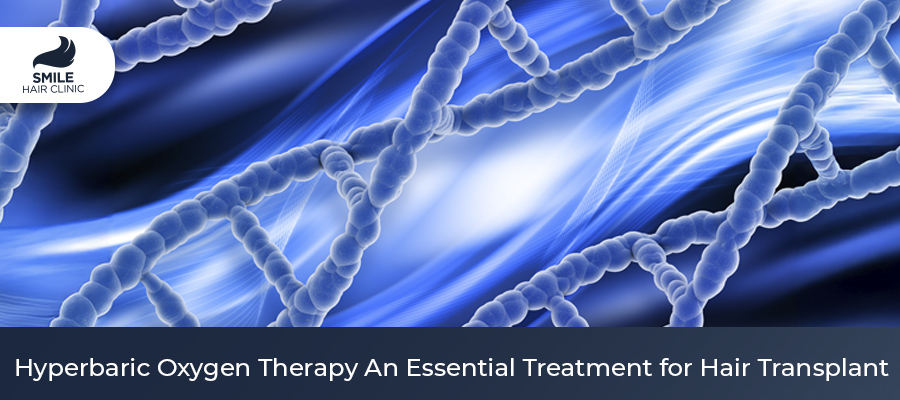What Makes Hyperbaric Oxygen Therapy An Essential Treatment After A Hair Transplant?

What Makes Hyperbaric Oxygen Therapy An Essential Treatment After A Hair Transplant?
Another trending method for people who experience hair loss is Hair Transplant surgery, which is Hyperbaric Oxygen Therapy. Although hair transplants can restore hair, the recovery process plays a crucial role in the overall effectiveness of the transplant. Hyperbaric oxygen therapy (HBOT) is one novel post-surgical modality wherein the individual who had a hair transplant to improve healing and outcome.
What is HBO (Hyperbaric Oxygen Therapy)?
Hyperbaric oxygen therapy, or HBOT, is a treatment in which the patient breathes 100% pure oxygen in a sealed chamber at two to three times higher than normal atmospheric pressure. The increased air pressure helps the lungs absorb as much oxygen as possible under normal conditions. This additional oxygen is carried in the bloodstream to tissues requiring repair, triggering improved natural healing.

HBOT can offer numerous prospective advantages in the setting of a hair transplant, which can enhance the overall results.
- Accelerates Wound Healing
Hair transplant causes microtrauma to the scalp of extraction and implantation of hair follicles. It may take longer for these minor wounds to heal, so the healing is sped up by delivering more oxygen with hyperbaric oxygen therapy into the well-perfused tissues near where the follicles were put. This results in quicker cellular repair, a shorter time for scabs and incisions to heal, and the grafts securely held into place as the new transplants take hold.
- Reduces the swelling and inflammation.
It is not uncommon for the donor and recipient areas to be swollen after hair transplants due to inflammation. HBOTs are anti-inflammatory and help control the swelling faster. They may also reduce overall inflammation, which can help with faster recovery and postoperative pain. Reducing inflammation in the scalp also provides a better environment for hair follicles to grow and improves overall transplant survival rates.
- Improves Graft Survival
The survival of the transplanted hair follicles is one of the most important things for a successful hair transplant. The grafts need good blood flow and oxygen to take hold. HBOT increases blood flow and oxygen to the new follicles, making it one of the most essential forms of healing in the initial stages. Follicle survival requires a significantly more significant supply of oxygen, which is provided by this increased delivery, impacting the likelihood of graft rejection or failure.
- Minimizes Infection Risk
A hair trasplant is a form of surgery that always carries the threat of infection. During the procedure, small incisions are made, which can become subject to bacterial contamination. Strengthening the immune system simulates the body’s fight against infections from a cellular level. Since many pathogenic bacteria are not well-adapted for thriving in an oxygen-rich environment, HBOT’s mechanism of action is thought to create unfavourable conditions for bacterial colonization immediately following transplantation.
- Boosts Collagen Production
Medical applications: Collagen is crucial for wound healing and tissue regeneration. It increases collagen formation (an essential aspect of healing) and may assist in providing more structural integrity to the skin of the operation area. The more extensive collagen response also helps to provide the best environment for newly transplanted hair follicles, allowing them to produce a good crop of hair in the short term and providing a better support system for healthier, stronger hairs as they grow.
- Always Allows Faster Recovery Time
Ultimately, HBOT expedites wound healing, minimizes inflammation, increases graft survival, and minimizes the risk of infection, shortening the complete recovery period following a hair transplant. Patients receiving HBOT tend to recover those post-surgical symptoms (redness, itching, and discomfort) much faster. With quicker healing, patients can return to their regular routine, fully heal quickly, and enjoy hair transplantation results with less downtime.
- Enhances Hair Growth Results
Since HBOT supports increased blood flow and oxygen assistance and more efficient and higher production of collagen, it can also influence results regarding the quality of hair growth after transplantation. After a hyperbaric oxygen therapy treatment, patients have said that they are experiencing increased hair thickness, texture, and vitality. It is not only making the follicles survive, but they would also have some time under an oxygenated environment, thereby releasing healthier hair over the following months and years.

How is HBOT Used After Hair Transplant?
Hyperbaric oxygen therapy is not considered invasive and is often a relatively simple procedure for those who want it after hair supplementation or transplant. It usually consists of relaxing in a hyperbaric chamber for about 60-90 minutes per session. Multiple sessions over several weeks may be suggested depending on the surgeon’s advice and the individual’s healing progress.
There are several good reasons why patients undergoing hair transplant surgery should consider hyperbaric oxygen therapy (HBOT). HBOT helps to speed up the healing process of the wounds and decreases inflammation, which improves graft survival, resulting in a lowered risk of infection. Hence, recovery is much faster, and you are ensured that your transplant will be very successful with fewer complications. HBOT could be a valuable adjunct for patients interested in optimizing their results after transplantation.
As with any medical therapy, you should consult a surgeon or specialist if hyperbaric oxygen therapy suits your particular case. If treated properly, a successful hair transplant can result in the recovery of an all-natural hairline and even self-confidence.
 Whatsapp
Whatsapp
